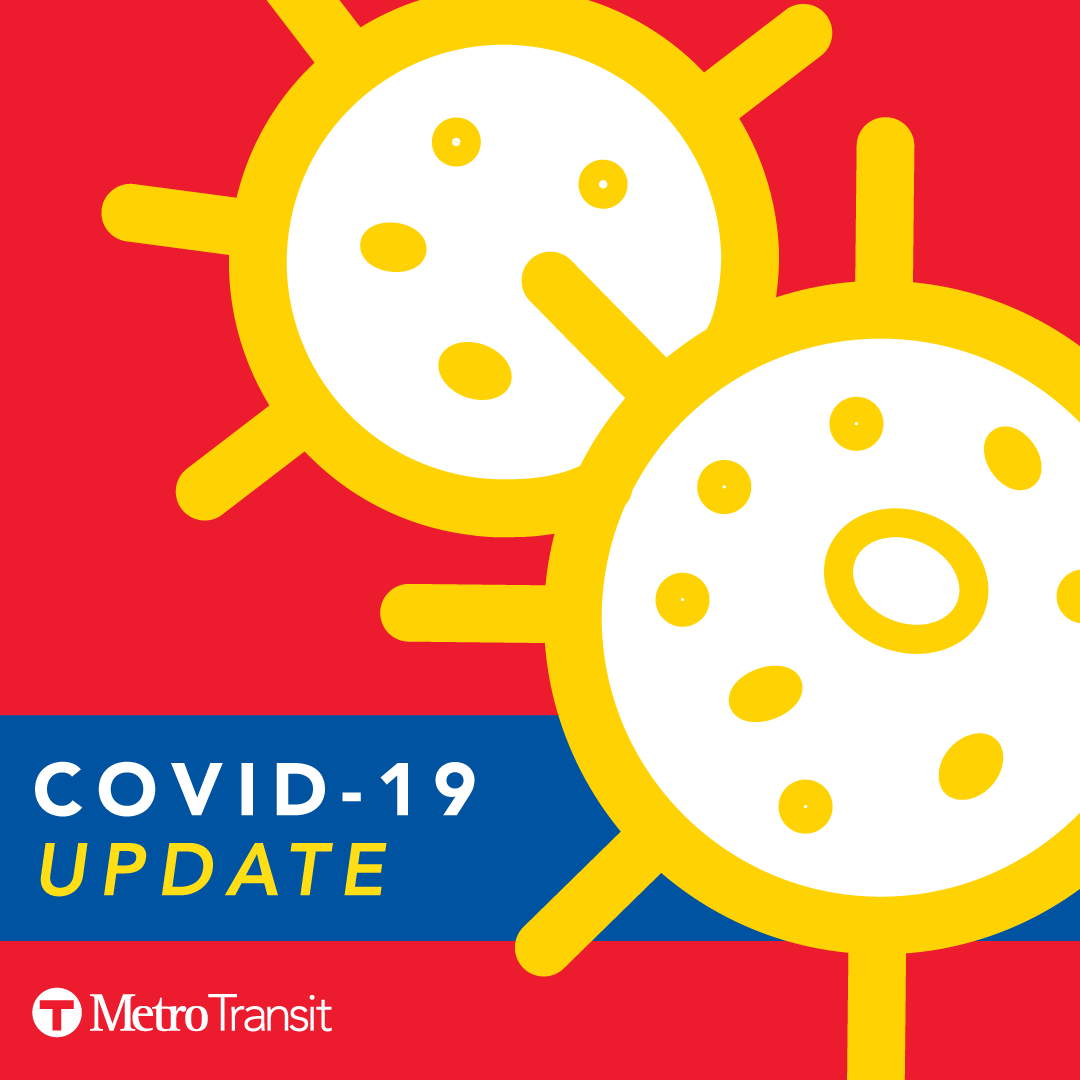
Several adjustments have been made to help prevent the spread of COVID-19, and changes are likely to continue as our understanding of the pandemic evolves. Below are responses to some frequently asked questions. Additional questions can be directed to Customer Relations.
For the latest updates, please visit metrotransit.org/health.
Last updated Aug. 20, 2021
Q. How are vehicles, stations, and platforms being cleaned?
Buses, trains, stations, and other shared spaces are being cleaned and disinfected as frequently as possible. Buses and light rail vehicles are cleaned daily. Drivers have supplies to sanitize their work areas at the beginning of each shift and bottles of sanitizer are available to staff.
We use a spray-on chemical (pH7Q) for daily use on vehicles; the EPA recognizes this product as being effective against COVID-19. Each week, we complete a deeper cleaning by wiping all surfaces with a separate EPA-approved product. We use pH7Q to spray shelter corners and high usage Park & Rides.
We also use Isopropyl 70% alcohol, which is the most versatile product for metals and high-touch areas including stainless steel, screens, railings, doors, etc. along with Clorox bleach wipes for many other surfaces.
Q. How is service being adjusted?
Service is regularly adjusted based on demand and resources. Review route schedules for the latest information. Service levels will continue to be evaluated as businesses, schools, and other services adapt to updated public health guidance. The latest adjustment of service took place on Dec. 4, 2021.
Q. How can I keep up to date on my route regarding returning service or suspensions?
Quarterly service changes take place in March, June, August, and December. For interim service changes, detours, stop closures, and suspended trips on the routes you regularly ride, sign up to receive Rider Alerts by email or text.
Q. Is there a limit on the number of people allowed onboard?
There are no longer capacity limits on buses and trains. To support social distancing, Metro Transit is closely monitoring ridership and assigning larger vehicles to the busiest routes.
It's still a good idea to spread out if possible onboard.
Q. Do I need to wear a mask when riding?
By federal mandate, customers are required to wear masks when waiting for and while riding buses and trains. Those failing to comply may be subject to police enforcement.
Q. Why can’t you add more buses to routes that regularly have overloads?
Service is regularly reviewed and adjusted based on demand. On Dec. 4, 2021, Metro Transit made its latest adjustments according to ridership and available resources. Review route schedules for the latest information.
Q. Is NexTrip accurate?
We are continually making upgrades to NexTrip accuracy, which is also available through third-party apps. Remember, alerts about scheduled service changes, detours, and trips that are unexpectedly canceled are provided by text and email. Sign up to receive alerts for the routes you use .
Q. How is the air on buses and trains being ventilated or filtered?
Drivers may open roof hatches to improve air circulation within buses. Customers may also open side windows on buses where windows can be opened. Metro Transit is researching enhanced air filtration options for buses and is installing enhanced air filters inside light rail vehicles.
Buses combine cabin air with 20% outside air and cycle it through an HVAC filter 55 times per hour on a 40-foot bus and 70 times per hour on a 60-foot articulated bus. That does not include added fresh air from open roof hatches, windows or doors.
In addition, we are testing photohydroionization (PHI) technology on two 40-foot and three 60-foot buses. This system creates hydrogen peroxide – an approved chemical known to kill viruses including the one that causes COVID-19 – by using moisture in the air and an ultraviolet light. We will test the effectiveness of this system with an ATP (Adenosine Triphosphate) tester. ATP is present in all organic material. The ATP tester will give us baseline measurements from highly touched surfaces on buses; we can then compare the baseline data to the test buses and judge the effectiveness of the PHI technology.
Q. What can customers do to help prevent the spread of COVID-19?
Remember to wash your hands, cover coughs and sneezes in a tissue or a sleeve, and avoid transit if you are feeling ill. When possible, leave space between yourself and others, and limit onboard conversation. Pay your fare touch-free with a Go-To Card or use the Metro Transit app. Always exit through the back door if you are able to do so.
Q. What do I do if I have concerns while riding?
Always call 911 in the event of an emergency. To report suspicious or unwanted behaviors, contact Text for Safety at 612-900-0411 and you will be put in touch with a trained representative who can provide assistance. For all other questions, comments, and concerns, call Customer Relations at 612-373-3333. Staff is available by phone Monday through Friday, 8 a.m. to 4:30 p.m.